This page has been expanded considerably since the original was written by Dave Cushman, mainly to include free fuels.
There are several types of commercially available smoker fuels, but quite frankly I can't see the need for buying it when there is fuel that is freely available and will do the same job at no cost. I have left the fuels that Dave Cushman had detailed below, which are largely commercially available ones, but I have modified the text and have written notes where I felt it was appropriate.
The best fuels burn slowly and give off instant smoke without continually puffing the bellows. If you need smoke, you need it now, not in 20-30 seconds time, otherwise you may have some stroppy bees that are difficult to control. Fuel should be in good condition, so it will burn readily. It is pointless having damp fuel, otherwise it may be difficult to keep the smoker alight.
I have listed some fuels below that I like. Some are what can be referred to as "primary" that are good for starting the smoker, and "secondary" that can be used once the smoker is well lit. The latter will have more "body" that will stay alight a lot longer.
The beekeeper with a keen eye will glean fuel at every opportunity. When out walking my dog I often gather smoker fuel. If it is damp I put it in the greenhouse to dry out. I handle a reasonably large number of colonies and keep my beekeeping kit in the car, as it is surprising how often it is needed. I generally have two plastic animal food bags, one with "primary" fuel, one with "secondary". I try to keep them reasonably full if I can, so I have dry fuel if it has been raining and what is available outside is wet.
Some fuels, e.g. wood shavings and bark chips will move around in the smoker fire box. They can then get blown out of the nozzle, perhaps with sparks too. To prevent this I take some grass and pack it in the fire box on top of the fuel.
Most of my beekeeping is done in a rural area, so there is usually suitable fuel available. If I can, I use what is available, rather than deplete my store that I may need elsewhere.
Some smoker fuels I like.
- Hay or dry long grass is usually plentiful, especially around farmyards and stables.
- Dry grass mowings. This can be turned with a fork to dry out quickly in the sun.
- Wood or bark chippings may need drying out in a greenhouse or conservatory.
- Egg trays are good for starting, but I find they burn quite quickly.
- Touchwood is my favourite, but it needs to be very light, so it breaks up easily.
- Hessian is good, but we no longer have as many sacks as we used to. Bricklayers cover their freshly laid bricks with long strips of hessian and this can be good. Leave it outside in the open to partly rot so it burns better.
- Corrugated cardboard needs to be rolled very tightly. I know it is mentioned below, but it has always amused me that beekeepers buy it when there is so much available. I have been involved with factories all my working life and I have never come across the "fire retardant" material that is always mentioned, to the point where I think it is one of beekeepings many myths.
- Dried leaves I don't bother to collect, but use if I'm working bees in woodland where they are freely available.
- Wood shavings can be good, but they are often mixed with sawdust, which I find doesn't burn well.
In addition to the above there are many things that I have used, especially if I'm out working the bees. This includes pine cones and needles. Once the smoker is well lit you will find it is best to pack the fuel into the firebox to prevent it burning too quickly.
Roger Patterson.
The following is largely the original page that Dave Cushman wrote.
Corrugated cardboard
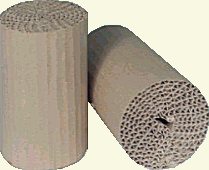
These are sold either singly or in packs by appliance dealers, but see the notes above. It should be rolled to form a cartridge that is just a little smaller than the firebox of the smoker. They tend to burn at a fairly high temperature, some say with an acrid smell. The type illustrated is formed from a type of material that has one flat laminate and one corrugated one.
If you make it yourself I find it better to roll it up loosly, then dig a hive tool in several places to create perforations. This allows it to be broken up and when rolled it gives a ragged edge that lights a lot easier than a straight cut edge.
Don't let the smoker burn out when you have finished using it. Lay it on it's side with the nozzle plugged with grass. This leaves part burnt fuel that is much better to light next time.
Coarse Tobacco

This by product from the tobacco industry consists of leaf stalks, thick leaf veins and tatty bits of tobacco leaf that have been rejected for use as recreational smoking materials.
This form of tobacco is most commonly found on mainland Europe, in use for bee smoker fuel. I believe that it is also one of the materials that are used in the German mouth powered "Imker Pfeife" type of smoker. I have not used this material myself, but I used to sell it when I was in business... It was a slow, but steady selling item.
Compressed Cotton
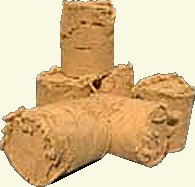

The illustrations at right show two type of compressed cotton smoker fuel.
I have had good reports of this material as it lasts a very long time before needing replenishment and it stays alight in a reliable fashion. It is good for beekeeping demonstrations for both of these reasons and is likely to stay alight between such demonstrations.
Burlap or Hessian Sacking
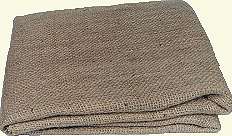
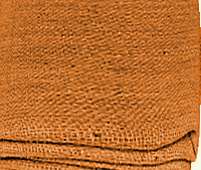
These fabrics smoulder in a slow and reliable fashion... The Burlap is far right.
If the material is to be cut from old, used, sacks... Then these should be left out of doors for a summer so that the rain can wash out any residue of whatever the sacks may have originally contained.
I have no experience of freshly made burlap cloth, but I have used a good deal of weathered and partially rotted material. I have tried both fresh and used hessian and find that the used material is easier to ignite than the freshly made cloth which has a hard shine to the surface of the fibres.
Herbal Smoker Fuel
There are various herbal mixtures used for this purpose, but as yet I have little information, when I have found out more about it I will put the details here.
I was sent the following information by a Danish guy... Jens Jørgen Krag Hansen.
"I have used lavender as fuel in my smoker with very good results. It is cut into small pieces using a compost shredder.
It has a calming effect on the bees and smells a great deal better then anything else I have tried."
Compressed Wood chip pellets
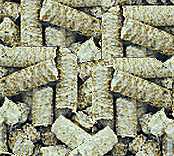
These are available in the USA, but I have not seen any on sale in UK so far. Several U.S. appliance dealers list it and claim that it is clean burning. My own experiences with wood shavings that result from manual planing of timber, would lead me to believe that the smoke would be rather hot. However I did try some 11 mm cubes of wood that resulted from a repetitive machining operation... They worked well when they were first lit, but tended to form charcoal and as time elapsed the smoke became hotter and contained less aromatic or volatile components.
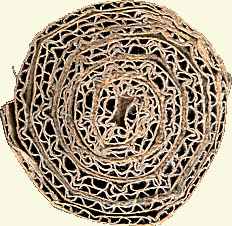
My personal favourite fuel is as follows:- Pre fabricated cartridges 70 mm in diameter about 70 mm in length... Made from strips of "burlap" sacking or other cloth interleaved with strips of corrugated cardboard that have been cut with the channels running across the strip. Once rolled into a cartridge the corrugations in the cardboard form a set of parallel channels that promote airflow and the mixture of the two types of material give a balanced, cool, fragrant and effective smoke. This home made fuel is convenient to carry and each cartridge lasts for rather more than an hour once lit. When a cartridge is part consumed a second one can be placed on top of the first for continuity. The corrugated cardboard used is of the "tri-wall" type recovered from cardboard boxes and the burlap is cut from old weathered sacks. The photograph at left gives clear detail of the construction. I collect the materials throughout the year and make up a large batch in early January. These are than packed in cardboard cartons for use whenever needed.
Having said all the above I must admit that I use very little smoke these days. I find that deft and sympathetic handling are all that is needed to handle "good quality bees".
A young lady in Scotland named Ann often grows sunflowers... She dries the stalks over the winter and cuts them into lengths to suit the firebox.
Many beekeepers recommend the fibrous rotting wood from the stumps of willow trees. I have used this material myself and would comment that extra fuel needs to be available as the rate of consumption is high and it works best if it is added little and often.
Dried grapevine prunings are said to pacify the bees, while being pleasant smelling to human noses.
Originally written by Dave Cushman. Edited by Roger Patterson.